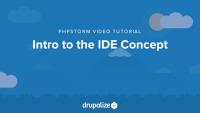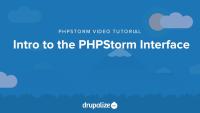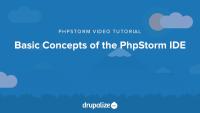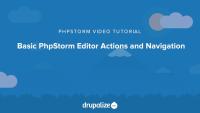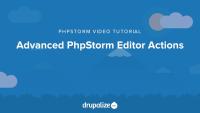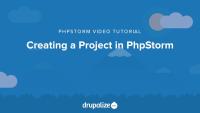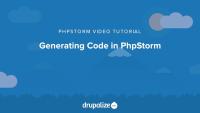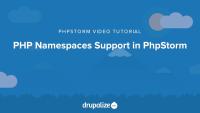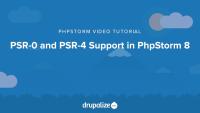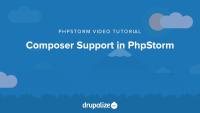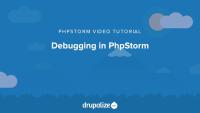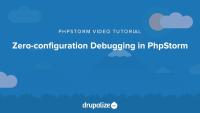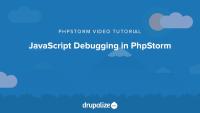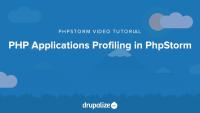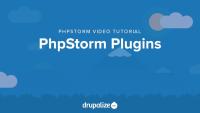This page is archived
We're keeping this page up as a courtesy to folks who may need to refer to old instructions. We don't plan to update this page.
Alternate resources
This series is about the PhpStorm IDE, showing you how to use an IDE for editing and debugging, along with some Drupal-specific tips. These tutorials are recorded by JetBrains, the creators of PhpStorm.
Please note that this series covers PhpStorm versions 6 and 7 only.
For the latest documentation (including up-to-date videos), see JetBrains documentation.
An Integrated Development Environment (IDE) offers many code editing tools in one application, making your job as a developer much easier. In this introductory video from JetBrains, the creators of PhpStorm, you will see what an IDE has to offer.
Additional resources
Please note that this series covers PhpStorm versions 6 and 7 only.
For the latest documentation (including up-to-date videos), see JetBrains documentation.
In this tutorial you will get an overview of the PhpStorm IDE interface. We'll look at the areas in the main window, including the toolbar, navigation, editor, and tool regions.
Additional resources
Please note that this series covers PhpStorm versions 6 and 7 only.
For the latest documentation (including up-to-date videos), see JetBrains documentation.
This tutorial covers concepts you should understand when working with an IDE versus a text editor. We'll discuss how the concept of Projects works in PhpStorm, what Content Roots are, and how you can work with external Libraries.
Additional resources
Please note that this series covers PhpStorm versions 6 and 7 only.
For the latest documentation (including up-to-date videos), see JetBrains documentation.
This tutorial breaks down the editor actions for PhpStorm. We take a look making mistakes in our code and how to see the errors and warnings that PhpStorm provides. We'll also work with the editor tabs, favorites, and bookmarks.
Corrections
At 2:22, the keyboard shortcut on Mac OS X should use the letter O, not N. Here are the correct commands and their alternatives for Mac OS X:
Navigate to Class by pressing Ctrl+N (command+O on Mac OS X)
Navigate to File by pressing Ctrl+Shift+N (shift+command+O on Mac OS X)
Navigate to Symbol by pressing Ctrl+Shift+Alt+N (option+command+O on Mac OS X)
Additional resources
Please note that this series covers PhpStorm versions 6 and 7 only.
For the latest documentation (including up-to-date videos), see JetBrains documentation.
In this PhpStorm tutorial we'll start working with some code in order to learn how to use code templates, and see the various ways that you can work with auto-completion and code generation options, which will save you a lot of time when coding. You'll also be able to see how the IDE provides you with solutions to fix errors in your code.
Additional resources
Please note that this series covers PhpStorm versions 6 and 7 only.
For the latest documentation (including up-to-date videos), see JetBrains documentation.
All of your work in PhpStorm will happen within a project. In this tutorial, we'll look at how to create a new empty project, or start one from existing files. We walk through the different types of projects you can start with, including Composer, and HTML templates, like Foundation and Twitter Bootstrap. We also take a look at setting up a project with remote servers.
Additional resources
Please note that this series covers PhpStorm versions 6 and 7 only.
For the latest documentation (including up-to-date videos), see JetBrains documentation.
PhpStorm can save you a lot of time by generating common code for you, including classes, constructors, getters, setters, and PHP doc blocks. We'll also look at common editor generation of things like loops.
See the written version of this tutorial for keyboard shortcuts.
Additional resources
Please note that this series covers PhpStorm versions 6 and 7 only.
For the latest documentation (including up-to-date videos), see JetBrains documentation.
Many languages use the concept of namespaces. PHP uses it to group together classes. This tutorial shows you how to work efficiently with namespaces in PhpStorm.
Additional resources
Please note that this series covers PhpStorm versions 6 and 7 only.
For the latest documentation (including up-to-date videos), see JetBrains documentation.
In this tutorial we'll explain what PSR-0 and PSR-4 namespacing is. Then we'll look at how to configure namespacing in PhpStorm 8. Drupal 8 is using PSR-4, so this is a really great tool to have when working in Drupal 8 projects.
Additional resources
Please note that this series covers PhpStorm versions 6 and 7 only.
For the latest documentation (including up-to-date videos), see JetBrains documentation.
Composer is a great PHP package manager, and in this tutorial you'll see how to work with Composer from within the PhpStorm IDE. To learn more about Composer, watch The Wonderful World of Composer video tutorial.
Additional resources
Composer project
Packagist.org
Please note that this series covers PhpStorm versions 6 and 7 only.
For the latest documentation (including up-to-date videos), see JetBrains documentation.
One of the great advantages of an IDE over a text editor is the ability to easily run a debugger. In this lesson you'll learn how to configure PhpStorm to use XDebug. We'll walk through getting XDebug set up, and then how to debug, including setting breakpoints.
Note: From the menu bar, PhpStorm > Preferences > PHP > Debug will apply settings to the current project as described in the video.
Additional resources
Please note that this series covers PhpStorm versions 6 and 7 only.
For the latest documentation (including up-to-date videos), see JetBrains documentation.
Once you have a debugger (like XDebug) set up on your system, you can use PhpStorm to run a web application and attach and detach the debugger at will. This tutorial will walk you through how to work with the debugger using the toolbar and bookmarklets.
Additional resources
Please note that this series covers PhpStorm versions 6 and 7 only.
For the latest documentation (including up-to-date videos), see JetBrains documentation.
PhpStorm also provides tools for debugging your JavaScript using a Chrome or Firefox extension with the IDE. This lesson shows how to set your breakpoints and walks you through the client-side debug process.
Additional resources
Please note that this series covers PhpStorm versions 6 and 7 only.
For the latest documentation (including up-to-date videos), see JetBrains documentation.
Profiling allows you to gather program execution statistics, like the number of functions, or how long a function takes to run. In this tutorial we walk through profiling with XDebug in PhpStorm.
Additional resources
Please note that this series covers PhpStorm versions 6 and 7 only.
For the latest documentation (including up-to-date videos), see JetBrains documentation.
Vagrant is a tool to create virtual machines that you can even share with others. In this tutorial you will learn how to create a new project that uses a Vagrant box and how mange it through PhpStorm. To learn more about Vagrant and how to set it up, watch the Introduction to Vagrant series.
Additional resources
Introduction to Vagrant series
Please note that this series covers PhpStorm versions 6 and 7 only.
For the latest documentation (including up-to-date videos), see JetBrains documentation.
When working with REST in your code, you can use PhpStorm's built-in REST Client to help you track and test your API code.
Additional resources
Please note that this series covers PhpStorm versions 6 and 7 only.
For the latest documentation (including up-to-date videos), see JetBrains documentation.
PhpStorm Plugins
FreeYou can extend PhpStorm's functionality with plugins. Adding plugins that enable vim integration, tools for working in NodeJS projects, or plugins that enable code completion and syntax highlighting for specific languages is as simple as searching for the package and clicking an install button. In this tutorial, you will review the plugins that already comes bundled with PhpStorm, as well as how to find and add new plugins for new features.
Additional resources
PhpStorm Plugin Library
Please note that this series covers PhpStorm versions 6 and 7 only.
For the latest documentation (including up-to-date videos), see JetBrains documentation.
PhpStorm has a Drupal plugin you can add to your IDE. In this tutorial you will learn how to configure the Drupal plugin and which new special features it provides, such as code generation, code completion, knowledge of Drupal coding standards, and more.
For more information about using PhpStorm with Drupal 8 and Symfony, read PhpStorm’s Symfony2-specific features for Drupal 8 tutorial from JetBrains.
Additional resources
Please note that this series covers PhpStorm versions 6 and 7 only.
For the latest documentation (including up-to-date videos), see JetBrains documentation.
